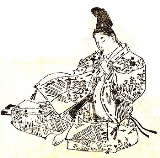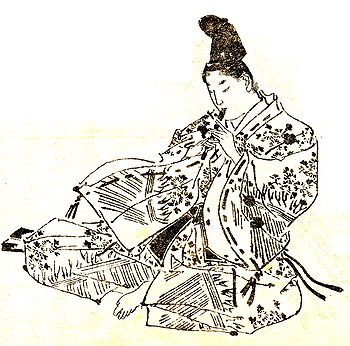
Taira no Atsumori
Encyclopedia

Samurai
is the term for the military nobility of pre-industrial Japan. According to translator William Scott Wilson: "In Chinese, the character 侍 was originally a verb meaning to wait upon or accompany a person in the upper ranks of society, and this is also true of the original term in Japanese, saburau...
famous for his early death in single combat. At the Battle of Ichi-no-Tani
Battle of Ichi-no-Tani
' was a Taira fortress at Suma, to the west of present-day Kobe. It sat on a very narrow strip of shore, between mountains on the north, and the sea to the south. This made it quite defensible, but also made it difficult to maneuver troops inside the fortress. Minamoto no Yoshitsune split his force...
, Atsumori engaged Kumagai Naozane
Kumagai Naozane
was a famous soldier who served the Genji Clan during the Heian period of Japanese history. Kumagai is particularly known for his exploits during the Genpei War, specifically for killing the young warrior Taira no Atsumori at the battle of Ichi-no-tani in 1184...
, an ally of the Minamoto, and was killed. Kumagai had a son the same age as Atsumori. Kumagai's great remorse as told in the tale, coupled with his taking of priestly vows, caused this otherwise unremarkable event to become well known for its tragedy.
The Death of Atsumori as told in the Tales of the Heike
The legend of Atsumori's death, as told in The Tales of the HeikeThe Tale of the Heike
is an epic account of the struggle between the Taira and Minamoto clans for control of Japan at the end of the 12th century in the Genpei War...
, goes as follows. The Heike were scattered by Yoshitsune's
Yoshitsune
may refer to:* Minamoto no Yoshitsune * Takuya Sugi , Japanese professional wrestler better known as Yoshitsune* Yoshitsune , a 2005 Japanese television drama series* Yoshitsune, a character in manga/anime Air Gear...
attack from the Ichi-no-Tani cliff. Kumagai no Jirō Naozane, while scanning the beach for fleeing soldiers, spotted the young Atsumori swimming towards the fleeing vessels. Kumagai beckons Atsumori with his fan, taunting Atsumori saying, “I see that you are a Commander-in-Chief. It is dishonorable to show your back to an enemy. Return!” (316, t. McCullough). The two grappled on the beach, but Kumagai was too powerful. Kumagai knocks off Atsumori's helmet to deliver the finishing blow, only to be struck by the beauty of the young noble. Atsumori was “sixteen or seventeen years old, with a lightly powdered face and blackened teeth—a boy just the age of Naozane's own son...” (317, t. McCullough).
Kumagai, wishing to spare the boy, asks for Atsumori's name, but the child refuses. Atsumori simply says that he is famous enough that Kumagai's superiors will recognize his head when it is time to assign rewards. At that moment, other Minamoto warriors arrived at the scene, and Kumagai knows that if he doesn't kill Atsumori, the other warriors surely will. Kumagai reasons that it is better if he is the one to kill Atsumori, because he can offer prayers on his behalf for the afterlife. Crying, Kumagai beheads the boy. Searching the body for something to wrap the head in, he came across a bag containing a flute. He realized that Atsumori must have been one of the soldiers playing music before the battle and thought, “There are tens of thousands of riders in our eastern armies, but I am sure none of them has brought a flute to the battlefield. Those court nobles are refined men!” (317, t. McCullough).
It is said that the beheading of Atsumori is what led Kumagai to take priestly vows and become a Buddhist monk.
Atsumori in other works
The Atsumori narrative became the subject of many spin-offs, including:- The NohNoh, or - derived from the Sino-Japanese word for "skill" or "talent" - is a major form of classical Japanese musical drama that has been performed since the 14th century. Many characters are masked, with men playing male and female roles. Traditionally, a Noh "performance day" lasts all day and...
play, AtsumoriAtsumori (play)' is a Japanese Noh play by Zeami Motokiyo which focuses on Taira no Atsumori, a young samurai who was killed in the Genpei War, and his killer, Kumagai Naozane...
, which follows Kumagai, now known as the Buddhist priest Renshō, as he speaks with and prays for the lost soul of Atsumori. - The BunrakuBunraku, also known as Ningyō jōruri , is a form of traditional Japanese puppet theater, founded in Osaka in 1684.Three kinds of performers take part in a bunraku performance:* Ningyōtsukai or Ningyōzukai—puppeteers* Tayū—the chanters* Shamisen players...
puppet play, later adapted for KabukiKabukiis classical Japanese dance-drama. Kabuki theatre is known for the stylization of its drama and for the elaborate make-up worn by some of its performers.The individual kanji characters, from left to right, mean sing , dance , and skill...
, Ichinotani Futaba Gunki - A Narrative: Atsumori, which expands upon the Tales of the Heike version and includes a section where Kumagai personally returns the body of Atsumori to the Minamoto.
- Little Atsumori, the tale of the resulting plight of Atsumori's wife and his yet unborn son.
- The lesser-known KabukiKabukiis classical Japanese dance-drama. Kabuki theatre is known for the stylization of its drama and for the elaborate make-up worn by some of its performers.The individual kanji characters, from left to right, mean sing , dance , and skill...
play Sakigake Genpei Tsutsuji (otherwise called Ogiya Kumagai, or Suma no Miyako Genpei Tsutsuji), where Atsumori hides his identity by dressing up as the girl Kohagi and working in a fan shop.

